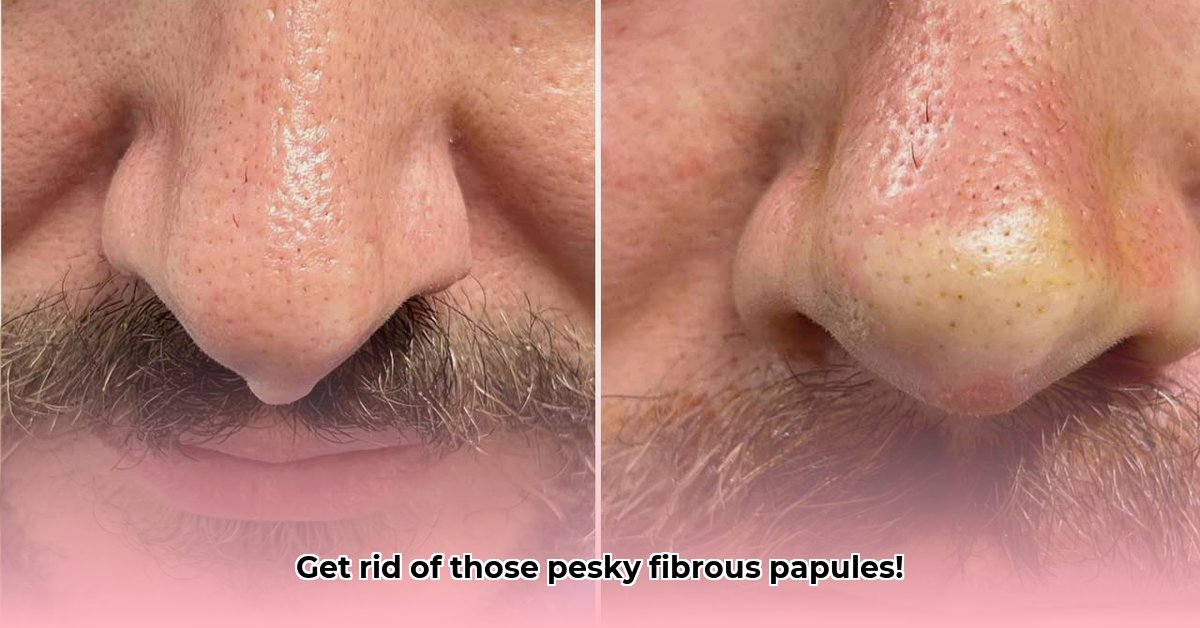Do small bumps on your nose or face bother you? Many people experience fibrous papules, firm skin growths that can be a cosmetic concern. This comprehensive guide provides information on fibrous papules, details safe and effective removal methods, and offers expert advice for clearer, healthier-looking skin. Explore treatment options, including advanced surgical and laser techniques, to enhance your confidence. For information on insurance coverage, see our guide.
Understanding Fibrous Papules and Treatment Options
Fibrous papules manifest as small, firm, flesh-colored or slightly darker bumps. While harmless, they can be bothersome and affect your self-esteem. This section will guide you through safe and effective removal methods, offering insights for a successful outcome. Clearer skin is achievable with the right approach.
What Are Fibrous Papules?
Fibrous papules are benign skin growths composed of collagen and fibrous tissue. They commonly appear on the nose, particularly in adolescents and young adults. These non-cancerous and non-contagious bumps rarely cause pain or discomfort. Their prominent location often leads individuals to seek removal for cosmetic reasons. The decision to remove them is about enhancing your appearance and confidence, not treating a medical illness.
Benefits of Fibrous Papule Removal: Boosting Confidence
The primary motivation for fibrous papule removal is cosmetic. These bumps can impact self-esteem and overall self-image. Safe and effective procedures can provide clearer skin and greater confidence. Getting rid of these bumps is about boosting your confidence and improving how you feel about your appearance.
The Importance of Consulting a Dermatologist
Consulting a board-certified dermatologist is essential for fibrous papule removal. Dermatologists are skin experts who can accurately diagnose the bumps and determine the most suitable removal technique for your skin type and condition. Attempting at-home removal is risky, potentially leading to scarring, infection, or incomplete removal. A professional touch ensures safety and optimal results.
Safe and Effective Removal Methods: A Detailed Look
Several reliable methods exist for fibrous papule removal, each with its benefits: surgical excision, cryotherapy, laser therapy, and electrocautery. Your dermatologist’s recommendation will depend on factors such as papule size, location, skin type, and individual preferences.
- Surgical Excision: A precise surgical procedure involving a small incision to remove the papule. This method often results in minimal scarring due to the dermatologist’s careful technique.
- Cryotherapy (Freezing): Liquid nitrogen is used to freeze off the papule. This quick procedure may cause a brief stinging sensation. Cryotherapy is best for smaller papules.
- Laser Therapy: A laser is used to vaporize the papule, offering a minimally invasive approach with faster healing. Different types of lasers can be used, depending on the papule’s characteristics and your skin type.
- Electrocautery: An electric current is used to burn off the papule. This method is effective but may carry a slightly higher risk of scarring compared to other options.
Recovery and Aftercare: Maximizing Results
Recovery duration varies depending on the removal method. Mild discomfort, redness, or swelling might occur post-procedure. Your dermatologist will provide specific aftercare instructions to ensure proper healing and minimize the risk of infection or scarring. Following these guidelines is crucial for the best possible outcome. Scarring is generally minimal and often fades over time with proper care.
Potential Risks: Understanding the Possibilities
While fibrous papule removal is generally safe, it’s important to understand potential risks. These risks are minimal when the procedure is performed by a qualified dermatologist. Complications are more likely with at-home removal attempts.
| Technology/Treatment | Risk of Scarring | Risk of Infection | Risk of Recurrence |
|---|---|---|---|
| Surgical Excision | Very Low | Very Low | Very Low |
| Cryotherapy | Low | Very Low | Low |
| Laser Therapy | Very Low | Very Low | Low |
| Electrocautery | Low to Moderate | Low | Low |
| At-Home Remedies | High | High | High |
Addressing Scarring and Infection Concerns
Many individuals worry about scarring. While possible, especially with electrocautery or procedures performed by inexperienced practitioners, scarring is usually minimal and fades over time. Proper technique and diligent aftercare minimize this risk. Infection is another concern, but it’s rare with appropriate post-procedure care and adherence to your dermatologist’s instructions.
The Importance of Accurate Diagnosis
Before any treatment, a dermatologist must confirm that the growth is indeed a fibrous papule. Other skin conditions, including skin cancer, may resemble fibrous papules. A skin biopsy might be necessary for accurate diagnosis. Self-diagnosis and treatment are strongly discouraged because other conditions can mimic fibrous papules.
When to Seek Professional Help
For numerous papules, a family history of skin conditions, or any unusual changes in a skin growth, schedule a consultation with a dermatologist promptly. Early detection and accurate diagnosis are paramount for effective management and peace of mind. If you notice a bump on your nose—or anywhere on your body—that concerns you, make an appointment with a dermatologist.
Laser Therapy Options for Nose Bumps
Laser therapy offers an effective solution for eliminating nose bumps. Different laser types can be tailored to your skin type and the specific characteristics of the fibrous papule, ensuring optimal results. This section will explore the laser options available and what to expect during the procedure. Benefits of laser therapy include faster healing times, minimal scarring, and precision targeting of the papule.
Types of Laser Therapy
- CO2 Laser: This ablative laser precisely vaporizes the fibrous papule, promoting collagen remodeling and smoother skin.
- Pulsed Dye Laser (PDL): This laser targets blood vessels within the papule, reducing redness and inflammation. It’s particularly useful for papules with a reddish hue.
Expect a quick procedure in a dermatologist’s office, typically with a topical anesthetic to minimize discomfort. Post-treatment, some redness and swelling are normal but usually subside within a few days.
Achieving Clearer and More Confident Skin
Fibrous papule removal is a safe and effective way to achieve clearer skin and boost self-confidence. Choosing a qualified, board-certified dermatologist is crucial for successful results and minimizing potential risks. Following post-procedure instructions diligently will lead to clearer skin and a more confident you.
Distinguishing Fibrous Papules from Basal Cell Carcinoma
Distinguishing between fibrous papules and basal cell carcinoma (BCC), a common form of skin cancer, is crucial for appropriate care. This section compares the characteristics of each condition, highlighting key differences to aid in early detection. Knowing what to look for is the first step in protecting your skin health.
Fibrous Papules vs. Basal Cell Carcinoma: Key Differences
Fibrous papules are small, firm, and generally painless bumps often found on the nose. BCC, however, can present as a bump, but may also appear as an open sore that bleeds, crusts, or scabs over, and persists for weeks. BCC can also manifest as a pearly or waxy bump, or a flat, scar-like lesion. Accurate identification is essential for timely treatment.
Identifying the Differences: A Side-by-Side Comparison
| Feature | Fibrous Papule | Basal Cell Carcinoma (BCC) |
|---|---|---|
| Appearance | Small, firm, dome-shaped bump; flesh-toned | Varied; pearly/waxy bump; open sore; scar-like lesion |
| Symptoms | Typically asymptomatic | May itch, bleed, crust, or ulcerate |
| Growth Rate | Slow or stable | Can grow slowly but steadily |
| Location | Predominantly on the nose | Any sun-exposed area |
| Texture | Smooth | Can be rough, scaly, or ulcerated |
| Border | Well-defined | May have irregular or poorly defined borders |
Dermatologists are trained to differentiate between these skin conditions. If you notice a bump on your nose—or anywhere on your body—that concerns you, make an appointment with a dermatologist for evaluation.
Fibrous Papule Treatment for Adolescent Skin
Adolescent skin requires specialized care when addressing fibrous papules. This section explores treatment options tailored to the unique needs of teenage skin, emphasizing gentle and effective approaches to minimize potential complications. Adolescent skin requires careful consideration during treatment due to its sensitivity.
Choosing the Right Approach for Sensitive Skin
Adolescent skin is often more sensitive and prone to reactions, so treatment should prioritize gentler, less invasive options that minimize inflammation and scarring. Dermatologists often recommend treatment plans tailored to the individual teen’s skin type and the characteristics of the papule.
Treatment Options for Teens
- Surgical excision: Allows for complete removal of the papule with precise control, minimizing damage to surrounding tissue.
- Electrocautery: This uses heat to destroy the papule. This technique is quick and generally effective, but needs to be done carefully to prevent scarring.
- Cryotherapy (freezing): Freezing the papule with liquid nitrogen. This is a relatively simple and often effective technique for smaller papules.
- Laser Therapy: Lasers can precisely target and remove the papule with minimal impact on surrounding skin.
Key Takeaways: What You Need to Know
- Fibrous papules are small, benign skin growths
- Gluten Free Meal Prep Ideas for Delicious, Hassle-Free Eating - November 28, 2025
- Gluten Free Meal Prep for Stress-Free and Healthy Eating - November 27, 2025
- Quick And Easy Chicken Thigh Meal Prep For Weight Loss - November 26, 2025










